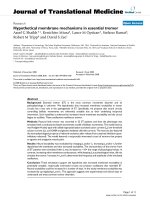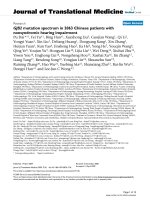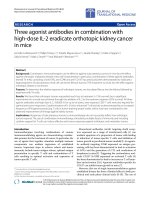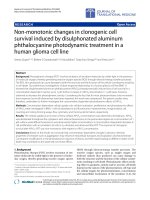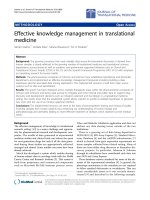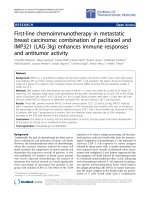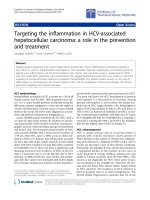báo cáo hóa học: " Experimental allergic encephalomyelitis in pituitary-grafted Lewis rats" pptx
Bạn đang xem bản rút gọn của tài liệu. Xem và tải ngay bản đầy đủ của tài liệu tại đây (310.43 KB, 5 trang )
BioMed Central
Page 1 of 5
(page number not for citation purposes)
Journal of Neuroinflammation
Open Access
Short report
Experimental allergic encephalomyelitis in pituitary-grafted Lewis
rats
Ana I Esquifino*
1
, Pilar Cano
1
, Agustín Zapata
2
and Daniel P Cardinali
3
Address:
1
Departamento de Bioquímica y Biología Molecular III, Facultad de Medicina, Universidad Complutense de Madrid, Spain,
2
Departamento de Biología Celular, Facultad de Ciencias Biológicas, Universidad Complutense de Madrid, Spain and
3
Departamento de
Fisiología, Facultad de Medicina, Universidad de Buenos Aires, 1121 Buenos Aires, Argentina
Email: Ana I Esquifino* - ; Pilar Cano - ; Agustín Zapata - ;
Daniel P Cardinali -
* Corresponding author
Abstract
Treatment of susceptible rats with dopaminergic agonists that reduce prolactin release decreases
both severity and duration of clinical signs of experimental allergic encephalomyelitis (EAE). To
assess to what extent the presence of an ectopic pituitary (that produces an increase in plasma
prolactin levels mainly derived from the ectopic gland) affects EAE, 39 male Lewis rats were
submitted to pituitary grafting from littermate donors. Another group of 38 rats was sham-
operated by implanting a muscle fragment similar in size to the pituitary graft. All rats received
subcutaneous (s.c.) injections of complete Freund's adjuvant (CFA) plus spinal cord homogenate
(SCH) and were monitored daily for clinical signs of EAE. Animals were killed by decapitation on
days 1, 4, 7, 11 or 15 after immunization and plasma was collected for prolactin RIA. In a second
experiment, 48 rats were immunized by s.c. injection of a mixture of SCH and CFA, and then
received daily s.c. injections of bromocriptine (1 mg/kg) or saline. Groups of 8 animals were killed
on days 8, 11 or 15 after immunization and plasma prolactin was measured. Only sham-operated
rats exhibited clinical signs of the disease when assessed on day 15 after immunization. A
progressive decrease in plasma prolactin levels was observed in pituitary-grafted rats, attaining a
minimum 15 days after immunization, whereas plasma prolactin levels were increased during the
course of the disease in sham-operated rats. Plasma prolactin levels were higher in pituitary-grafted
rats than in sham-operated rats 1 day after immunization, but lower on days 7, 11 and 15 after
immunogen injection. Further supporting a correlation of suppressed prolactin levels with absence
of clinical signs of EAE, rats that were administered the dopaminergic agonist bromocriptine
showed very low plasma prolactin levels and did not exhibit any clinical sign of EAE. These results
indicate that low circulating prolactin levels coincide with absence of clinical signs of EAE in Lewis
rats.
Findings
Experimental allergic encephalomyelitis (EAE) is one of
best-studied models of autoimmune disease, and is char-
acterized by an autoimmune attack on CNS myelin medi-
ated by neural autoantigen-specific T helper cells [1]. EAE
is currently the best available animal model of human
multiple sclerosis. During induction of EAE, autoreactive
T-cells are activated in the periphery by subcutaneous
Published: 23 August 2006
Journal of Neuroinflammation 2006, 3:20 doi:10.1186/1742-2094-3-20
Received: 01 June 2006
Accepted: 23 August 2006
This article is available from: />© 2006 Esquifino et al; licensee BioMed Central Ltd.
This is an Open Access article distributed under the terms of the Creative Commons Attribution License ( />),
which permits unrestricted use, distribution, and reproduction in any medium, provided the original work is properly cited.
Journal of Neuroinflammation 2006, 3:20 />Page 2 of 5
(page number not for citation purposes)
injection of either spinal cord homogenate (SCH) or CNS
antigens, which may include myelin basic protein, myelin
oligodendrocyte glycoprotein, or proteolipid protein or
their peptides [2]. About 10 days after the combined injec-
tion of complete Freund adjuvant (CFA) and spinal cord
homogenate (SCH), susceptible rats (e.g., Lewis rats)
develop a progressive paralysis associated with CNS
demyelinization. Activated, autoreactive T-cells access the
CNS and, in the presence of competent antigen presenting
cells, are further activated and induce a local inflamma-
tory response. In most such models, the T helper 1 (Th1)
subset of T-cells has been implicated in the induction
phase of EAE.
It is well established that prolactin is an important modu-
lator of the immune system through an effect that is
exerted in part on the cellular arm of immune defense
involving Th1 cytokines [3,4]. Factors that cause hypopro-
lactinemia are generally associated with reduced immu-
nocompetence, whereas prolactin administration restores
immunocompetence in hypophysectomized rats or bro-
mocriptine-treated rats [5-7]. On the other hand, signifi-
cant immune-suppressive effects of prolactin have been
noticed: several investigators have reported that prolactin
decreases natural killer cell migration and activity and
reduces lymphocyte proliferative capacity and cytokine
release in rodents [7-9]. Of relevance to EAE is the obser-
vation that treatment of animals with dopaminergic ago-
nists which reduce prolactin release decreases both
severity and duration of clinical signs of the disease
[10,11].
Since changes in prolactin secretion could modulate EAE
symptomatology, we wished to assess to what extent the
presence of an ectopic pituitary, producing an increase in
plasma prolactin levels mainly derived from the ectopic
gland [12], would affect EAE. The consequence of inhibit-
ing prolactin secretion by injecting the dopaminergic ago-
nist bromocriptine was also assessed.
Male Lewis rats (6 weeks old, 140–170 g) were purchased
from Charles River S.A., Spain, and were housed under
standard conditions of controlled light (12:12 h light/
dark schedule, light on at 0800 h) and temperature (22 ±
2°C). All experiments were conducted in accordance with
the guidelines of the International Council for Laboratory
Animal Science (ICLAS). Protocols were approved by the
Institutional Animals Ethics Committee. Spinal cord,
obtained from adult Wistar rats, was homogenized in PBS
buffer at a concentration of 1 mg/ml to serve as an immu-
nogen (SCH).
Two experiments were performed. In experiment 1, 39
rats were subjected to pituitary grafting from littermate
donors. Animals were anesthetized with 2.5% tribro-
moethanol in saline (1 ml/100 g body weight). Another
group of 38 rats of the same age was sham-operated (by
implanting a muscle fragment of a size similar to the pitu-
itary graft) to be used as a control group. Rats were left
undisturbed for 4 weeks – i.e., until the time at which
increased prolactin levels in pituitary grafted animals
attains a plateau [13] – at the end of which time all ani-
mals were immunized by subcutaneous (s.c.) injection of
a mixture of SCH and CFA containing Mycobacterium
tuberculosis H37Ra (5 mg/ml; Difco Laboratories,
Detroit, Michigan) (v/v) in a final volume of 200 μl. Ani-
mals were monitored daily for clinical signs of EAE using
the following assessment scale: 0, normal; 0.5, loss of
tonicity in distal half of tail; 1, piloerection; 2, total loss of
tail tonicity; 3, hind leg paralysis; 4, paraplegia; and 5,
moribund [14]. The rats were killed by decapitation on
days 1, 4, 7, 11 or 15 after immunization (7–8 animals per
group) and blood was collected from a trunk wound into
heparinized tubes and was centrifuged. Plasma was col-
lected and stored at -20°C until further analysis. Visual
assessment of the grafts at the time of sacrifice did not
show any gross differences between groups.
In experiment 2, 48 male Lewis rats were immunized with
SCH plus CFA mixture, and then received daily s.c. injec-
tions of bromocriptine (1 mg/kg) or saline (n = 24 each).
Animals were monitored daily for clinical signs of EAE
and were killed by decapitation on day 8, 11 or 15 after
immunization (8 animals per group), and blood was col-
lected from a trunk wound.
Plasma prolactin levels were measured by a homologous
specific double antibody RIA [15], using materials kindly
supplied by the NIDDK's National Hormone and Pitui-
tary Program and Dr. A. Parlow (Harbor UCLA Medical
Center, Torrance CA 90509). The intra- and interassay
coefficients were 6–8%. Sensitivity of the RIA was 40 pg/
ml using the NIDDK rat prolactin RP-3 standard. Results
were expressed as pg/ml of plasma. Statistical analysis of
results was performed by employing either Student's t test,
a factorial analysis of variance (ANOVA), or a one-way
ANOVA followed by a Student-Newman-Keuls test.
Figure 1 depicts the results of both experiments. The evo-
lution of clinical scores of EAE in control and pituitary-
grafted rats is shown in the upper left panel. Only sham-
operated rats exhibited clinical signs of the disease when
assessed on day 15 after immunization. Clinical scoring at
this state of disease did not differ from that previously
reported, using similar conditions, for both rats [16] and
mice [17]. Prolactin levels in both experimental groups
are shown in the lower left panel. A significant interaction
"treatment × time" was found in the factorial ANOVA, i.e.
plasma prolactin levels were higher in pituitary-grafted
rats than in sham-operated rats 1 day after immunization
Journal of Neuroinflammation 2006, 3:20 />Page 3 of 5
(page number not for citation purposes)
and lower on days 7, 11 and 15 after immunogen injec-
tion (p < 0.001) (lower left panel). A progressive decrease
in plasma prolactin levels was observed in pituitary-
grafted rats, attaining a minimum 15 days after immuni-
zation (p < 0.01). In contrast, prolactin levels were
increased during the course of the disease in sham-oper-
ated rats (p < 0.05). This increase in prolactin levels was
presumably a response to the administration of CFA.
Although the clinical onset of inflammatory disease fol-
lowing CFA occurs between days 12 and 15 after injection,
the increase in plasma prolactin is already demonstrable
at an early phase of the disease [18,19].
Mild hyperprolactinemia has been found to enhance sev-
eral autoimmune diseases, including systemic lupus ery-
thematosus, rheumatoid arthritis and autoimmune
thyroiditis [6,7,20]. In studies of EAE, prolactin levels
have been found to be elevated before the onset and dur-
ing the disease [21], as observed in sham-operated ani-
mals in the present study. Therefore, a feasible
Effect of changing plasma prolactin levels on clinical signs of EAE in ratsFigure 1
Effect of changing plasma prolactin levels on clinical signs of EAE in rats. Two experiments were performed. In experiment 1
(left upper and lower panels), 77 male Lewis rats were subjected either to pituitary grafting from littermate donors (n = 39) or
to sham operations (n = 38); all were then immunized by s.c. injection of a mixture of spinal cord homogenate (SCH) and com-
plete Freund's adjuvant (CFA) as described in Methods. Rats were monitored daily for clinical signs of EAE. Groups of 7–8 rats
were killed by decapitation on day 1, 4, 7, 11 or 15 after immunization. In experiment 2 (right upper and lower panels), 48 male
Lewis rats were immunized with SCH plus CFA mixture, and then received daily s.c. injections of bromocriptine (1 mg/kg) or
saline (n = 24 each). Groups of 8 rats were killed by decapitation on day 8, 11 or 15 after immunization. Prolactin levels were
measured by RIA. Data are shown as means ± SEM. ** p < 0.01 vs. grafted rats at each time interval, Student's t test. Super-
scripts designate significant differences among time intervals within the same experimental group,
a
p < 0.01 vs. sham-operated
rats on days 7, 11 or 15;
b
p < 0.05 vs. pituitary-grafted rats on day 1;
c
p < 0.05 vs. pituitary-grafted rats on days 4 or 7, p < 0.01
vs. pituitary-grafted rats on day 1, one-way ANOVA, Student-Newman-Keuls test.
Journal of Neuroinflammation 2006, 3:20 />Page 4 of 5
(page number not for citation purposes)
explanation for the lack of clinical signs of EAE on day 15
after immunization in pituitary-grafted rats is a relative
lack of prolactin.
Further supporting the correlation of suppressed prolactin
levels with absence of clinical signs of EAE is the observa-
tion that rats administered the dopaminergic agonist bro-
mocriptine did not exhibit any clinical sign of disease
(Fig. 1, upper right panel). Bromocriptine treatment was
very effective in preventing prolactin release at all exam-
ined time points (p < 0.001) (Fig. 1, lower right panel).
In summary, these results indicate that low circulating
prolactin levels coincide with absence of clinical signs of
EAE in Lewis rats. Since the presence of an ectopic pitui-
tary would normally be expected to lead to increased
plasma prolactin levels, further studies are needed to
unravel why prolactin production by renal pituitary grafts
is suppressed during EAE development. These results also
confirm previous findings that treatment with dopamin-
ergic agonists induces a reduction of prolactin levels
accompanied by amelioration of the neurological signs of
EAE [10,11]. The effects of dopaminergic agents could be
related to their ability to lower prolactin concentrations
and/or to a neuroprotective action of the drugs.
Caution should be taken in extrapolating these results to
human disease as monophasic EAE, particularly in the
Lewis rat model, shares only some aspects of human mul-
tiple sclerosis. Indeed, contradictory results have been
published on the occurrence of hyperprolactinemia in
multiple sclerosis patients, with some studies finding
increased prolactin levels [22-24] while others do not [25-
27].
Competing interests
The author(s) declare that they have no competing inter-
ests.
Authors' contributions
AIE, PC and AZ carried out the experiments and the
immunoassays. DPC and AIE designed the experiments.
DPC also performed the statistical analysis and drafted
the manuscript. All authors read and approved the final
manuscript.
Acknowledgements
This work was supported by grants from FISS Madrid, Spain, Agencia
Nacional de Promoción Científica y Tecnológica, Argentina (PICT 14087)
and the Universidad de Buenos Aires (ME 075). DPC is a Research Career
Awarded from the Argentine Research Council (CONICET).
References
1. Wekerle H, Kojima K, Lannes-Vieira J, Lassmann H, Linington C: Ani-
mal models. Ann Neurol 1994, 36(Suppl):S47-S53.
2. Coyle PK: The neuroimmunology of multiple sclerosis. Adv
Neuroimmunol 1996, 6:143-154.
3. Takagi K, Suzuki F, Barrow RE, Wolf SE, Herndon DN: Recom-
binant human growth hormone modulates Th1 and Th2
cytokine response in burned mice. Ann Surg 1998, 228:106-111.
4. Majumder B, Biswas R, Chattopadhyay U: Prolactin regulates anti-
tumor immune response through induction of tumoricidal
macrophages and release of IL-12. Int J Cancer 2002,
97:493-500.
5. Nagy E, Berczi I, Wren GE, Asa SL, Kovacs K: Immunomodulation
by bromocriptine. Immunopharmacology 1983, 6:231-243.
6. Vera-Lastra O, Jara LJ, Espinoza LR: Prolactin and autoimmunity.
Autoimmun Rev 2002, 1:360-364.
7. Yu-Lee LY: Prolactin modulation of immune and inflamma-
tory responses. Recent Prog Horm Res 2002, 57:435-455.
8. Arce A, Castrillon P, Della Maggiore V, Cardinali DP, Esquifino AI:
Effect of cyclosporine on immune responses in submaxillary
lymph nodes of pituitary-grafted rats. Biol Signals 1996,
5:334-342.
9. Matera L, Mori M, Geuna M, Buttiglieri S, Palestro G: Prolactin in
autoimmunity and antitumor defence. J Neuroimmunol 2000,
109:47-55.
10. Canonico PL, Sortino MA, Favit A, Aleppo G, Scapagnini U: Dihydro-
ergocryptine protects from acute experimental allergic
encephalomyelitis in the rat. Funct Neurol 1993, 8:183-188.
11. Dijkstra CD, van der Voort ER, De Groot CJ, Huitinga I, Uitdehaag
BM, Polman CH, Berkenbosch F: Therapeutic effect of the D2-
dopamine agonist bromocriptine on acute and relapsing
experimental allergic encephalomyelitis. Psychoneuroendocrinol-
ogy 1994, 19:135-142.
12. Bartke A, Shrenker P: Effect of experimentally-induced chronic
hyperprolactinemia on testosterone and gonadotropin lev-
els in male rats and mice. Critical Rev Anat Sci 1987, 1:37-62.
13. Tresguerres JA, Esquifino AI: Dissociation in the regulation of
luteinizing hormone and follicle-stimulating hormone in a
hyperprolactinaemic rat model: interrelationships between
gonadotrophin and prolactin control. J Endocrinol 1981,
90:41-51.
14. Esquifino AI, Cano P, Jimenez V, Cutrera RA, Cardinali DP: Experi-
mental allergic encephalomyelitis in male Lewis rats sub-
jected to calorie restriction. J Physiol Biochem 2004, 60:245-252.
15. Castrillón P, Cardinali DP, Pazo D, Cutrera RA, Esquifino AI: Effect
of superior cervical ganglionectomy on 24-h variations in
hormone secretion from anterior hypophysis and in hypoth-
alamic monoamine turnover, during the preclinical phase of
Freund's adjuvant arthritis in rats. J Neuroendocrinol 2001,
13:288-295.
16. Stefferl A, Linington C, Holsboer F, Reul JM: Susceptibility and
resistance to experimental allergic encephalomyelitis: rela-
tionship with hypothalamic-pituitary-adrenocortical axis
responsiveness in the rat. Endocrinology 1999, 140:4932-4938.
17. Meehan TF, DeLuca HF: CD8
+
T cells are not necessary for 1
alpha,25-dihydroxyvitamin D
3
to suppress experimental
autoimmune encephalomyelitis in mice. Proc Natl Acad Sci U S
A 2002, 99:5557-5560.
18. Neidhart M, Fluckiger EW: Hyperprolactinaemia in hypophysec-
tomized or intact male rats and the development of adju-
vant arthritis. Immunology 1992, 77:449-455.
19. Selgas L, Arce A, Esquifino AI, Cardinali DP: Twenty-hour hour
rhythms of serum ACTH, prolactin, growth hormone and
thyroid-stimulating hormone, and of median eminence
norepinephrine, dopamine and serotonin, in rats injected
with Freund's adjuvant. Chronobiol Int 1997, 14:253-265.
20. Chikanza IC: Prolactin and neuroimmunomodulation: in vitro
and in vivo observations. Ann N Y Acad Sci 1999, 876:119-130.
21. Riskind PN, Massacesi L, Doolittle TH, Hauser SL: The role of pro-
lactin in autoimmune demyelination: suppression of experi-
mental allergic encephalomyelitis by bromocriptine. Ann
Neurol 1991, 29:542-547.
22. Kira J, Harada M, Yamaguchi Y, Shida N, Goto I: Hyperprolactine-
mia in multiple sclerosis. J Neurol Sci 1991, 102:61-66.
23. Azar ST, Yamout B: Prolactin secretion is increased in patients
with multiple sclerosis. Endocr Res 1999, 25:207-214.
24. Yamasaki K, Horiuchi I, Minohara M, Osoegawa M, Kawano Y, Ohyagi
Y, Yamada T, Kira J: Hyperprolactinemia in optico-spinal mul-
tiple sclerosis. Intern Med 2000, 39:296-299.
25. Wei T, Lightman SL: The neuroendocrine axis in patients with
multiple sclerosis. Brain 1997, 120:1067-1076.
Publish with Bio Med Central and every
scientist can read your work free of charge
"BioMed Central will be the most significant development for
disseminating the results of biomedical research in our lifetime."
Sir Paul Nurse, Cancer Research UK
Your research papers will be:
available free of charge to the entire biomedical community
peer reviewed and published immediately upon acceptance
cited in PubMed and archived on PubMed Central
yours — you keep the copyright
Submit your manuscript here:
/>BioMedcentral
Journal of Neuroinflammation 2006, 3:20 />Page 5 of 5
(page number not for citation purposes)
26. Heesen C, Gold SM, Bruhn M, Monch A, Schulz KH: Prolactin stim-
ulation in multiple sclerosis – an indicator of disease sub-
types and activity? Endocr Res 2002, 28:9-18.
27. Harirchian MH, Sahraian MA, Shirani A: Serum prolactin level in
patients with multiple sclerosis: a case control study. Med Sci
Monit 2006, 12:CR177-CR180.

